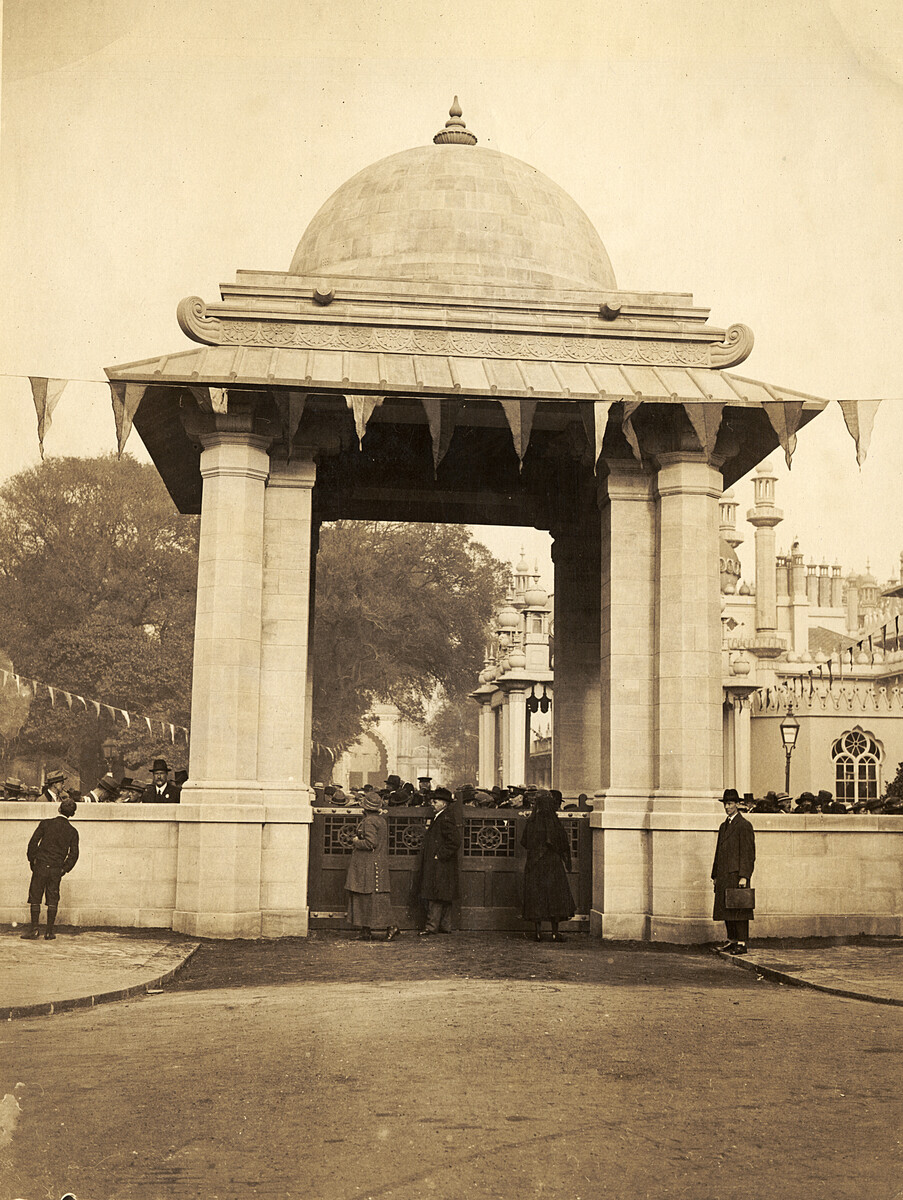Unveiling the Indian Gate

The southern entrance to the Royal Pavilion estate is marked by a large Indian style gate. Many visitors to Brighton probably assume that it was part of the original grounds, as it is loosely in keeping with the exterior of the Royal Pavilion. But it is a much later addition, and was unveiled on 26 October 1921.
The Indian Gate replaced a much lower gate that was erected by Brighton Corporation following its purchase of the Pavilion in 1850. Designed by Thomas Tyrwhitt, the Indian Gate is a dome resting on four pillars, in a style deriving from Gujarat.

It was constructed to mark the military hospitals established in Brighton during World War One, when approximately 12,000 Indian troops were treated in the town between late 1914 and early 1916. The Royal Pavilion was the most famous of these hospitals, and over 4,300 patients were treated in the buildings of the Pavilion, the Dome, and the Corn Exchange.
Although the Pavilion is the only hospital mentioned in the accompanying inscription, the Indian Gate also marks the role of the York Place Schools hospital (now demolished) and the Kitchener Hospital (now Brighton General Hospital), which had formerly been the town’s workhouse.

The Indian Gate was opened to the public by the Maharajah of Patiala, Bhupinder Singh, in a crowded ceremony on 26 October 1921. Singh had been a prominent supporter of the British cause during World War One, and in his speech during the ceremony he reminded the crowds that he had sent 28,000 troops from his own state to fight during the war.
During the ceremony, the Maharajah unlocked the gate with a gold key, claimed to be a replica of one of the original keys to the Royal Pavilion. He was accompanied in the ceremony by numerous local dignitaries, including the Mayor of Brighton, Bertram Southall; Alderman Charles Thomas-Stanford, former Brighton MP and the owner of Preston Manor; and Alderman John Otter. Otter had been Mayor of Brighton in 1914, and had offered up the Pavilion for use as a hospital for Indian men; as Chairman of the Indian Memorial Committee, he was a key figure in preserving the memory of Brighton’s Indian hospitals in the years immediately following the war.
The unveiling ceremony was extensively photographed, and was filmed by British Pathe.

After the ceremony, the Maharajah of Patiala was treated to a banquet in the Pavilion. Ticket holding guests could accompany the prince in a meal including boiled turbot, cold roast lamb and maraschino jelly.

Yet once the Maharajah left Brighton, and the bunting was removed, the purpose of the Indian Gate seems to have gradually slipped from memory. By World War Two, the Indian Gate had blended into the architecture of the Royal Pavilion, and the Chattri memorial was used for target practice by troops stationed in the area.
Interest in the story has revived in the last decade, thanks largely to the efforts of Bert Williams and others at Brighton and Hove Black History, Davinder Dhillon in setting up the annual Chattri Memorial Service, and Tom Donovan, in researching the Chattri’s history, and the identities of those men cremated there. The Indian Military Hospital gallery which opened in the Pavilion in 2010 has also helped to maintain interest in this episode.
Since the centenary of the First World, there has been fresh interest in the story of Brighton’s Indian patients, and the huge contribution made by these troops to the British war effort. But it is worth remembering in this story that the Indian Gate has a distinct and subtle legacy.
First, the Gate was not a monument funded by public money or by wealthy British benefactors. Its inscription describes it as the ‘gift of India’, and it was paid for by individuals from India, including the Maharajah of Patiala.

Second, the Indian Gate is often thought of as a war memorial, but its explicit purpose was never to directly remember those who died in the Brighton hospitals: that role is performed by the Chattri, which stands on the spot where 53 Hindu and Sikh men were cremated at an open ghat (although it also commemorates the Muslim soldiers who died in Brighton and were buried in Woking).
The Indian Gate was a gesture of thanks from the people of India to the people of Brighton for the care ‘of her sons who — stricken in the Great War — were tended in the Pavilion in 1914 and 1915’, and is ‘dedicated to the use of the inhabitants of Brighton’.
Indeed, it’s striking that during his speech at the opening ceremony, the Maharajah talked less of the sacrifices made by Indian men, and more about ‘Dr Brighton’, a popular reference to the town’s reputation as a place of healing. He described ‘Brighton’s abounding hospitality’ and claimed that the town’s fame as a healer ‘was talked of in many hundreds of remote Indian villages’.
It is important to remember that this speech was made at a time when British and Indian relations were becoming increasingly strained. Nationalist sympathies were growing in India, and fuelled by the perception of broken promises made by the British government during the war. The Amritsar Massacre of 1919, in which almost 400 people were killed by British troops firing without warning on a crowd of protesters, had exposed the occasional brutality of British rule. Many of those killed in the massacre were Sikhs, and the horror would have been still fresh in the mind of Bhupinder Singh, a fellow Sikh.
This political turmoil would eventually lead to the independence and partition of India in 1947, but even in 1921 it was clear that India was changing course. In this political climate, the Indian Gate can be seen as a reminder of an underlying friendship and respect that could exist between Britain and India; one that could be based on not just military support in a time of crisis, but a more positive history of healing.